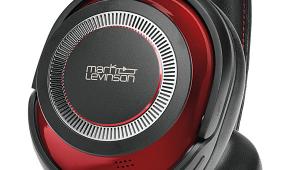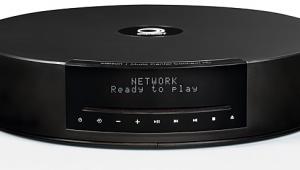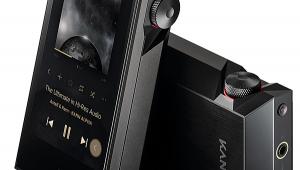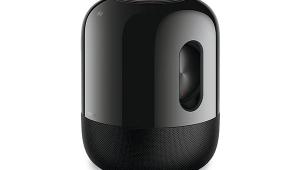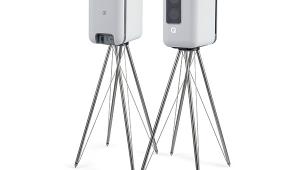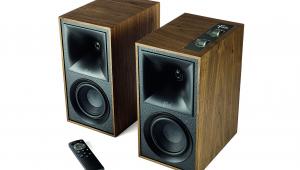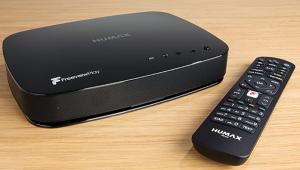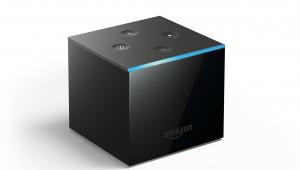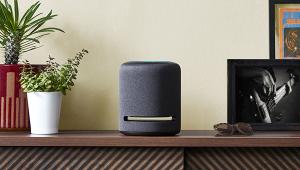NAD Masters Series M10 streaming amplifier review

 Looking to downsize your AV system? Ed Selley reckons that NAD might have made the perfect device to help you do just that...
Looking to downsize your AV system? Ed Selley reckons that NAD might have made the perfect device to help you do just that...
The market for high-performance all-in-one systems – where you simply add your own choice of loudspeakers – has exploded in recent years. Many of these devices have more than one eye on being used for AV replay as well as hi-fi, and NAD – with its Masters Series M10 system – is the latest company to build in some film-friendly functionality.
Offering a claimed 100W per channel (measured at 20Hz-20kHz into 8 ohms) across its two channels from a bespoke HybridDigital amplifier stage, it should have the horsepower needed to give your flatscreen a boost.
It's described as a ‘BluOS streaming amplifier’, referring to the integration of the BluOS operating system (also found on Bluesound products, NAD's sister brand). This offers excellent streaming performance with support for all the major music streaming services – Spotify, Tidal, Qobuz, Deezer and the recently launched Amazon Music HD tier all feature – and multiroom compatibility with other products from the same family, plus models from other BluOS supporters, such as loudspeaker brand DALI. And, thanks to rendering your music library on the device itself, it tends to be impressively fast and stable in use.
Of more interest to cinephiles, though, is what NAD has fitted to the M10 beyond the BluOS interface. Around the back, as well as optical and coaxial digital audio inputs, you’ll find an HDMI ARC connection that slaves the NAD to a suitably equipped TV.
This isn't unique (Naim's Uniti Atom, for example, also packs HDMI ARC), but where the M10 does break new ground is in bass management. Like many of these systems, you have a pre-out for attaching a subwoofer. More unusually, there are two pre-outs, and they're accompanied by a menu system that allows for individual crossover adjustment to make best use of your woofer(s).
Neither is NAD done there. This streaming amplifier is also equipped with Dirac (the required microphone is supplied) to calibrate your room/speakers. As standard, the subscription is for Dirac Live, which concentrates on bass management, but it can be upgraded to Dirac Live Full Frequency (unlocking correction from 20Hz-20kHz) if you wish. The combination of these two features means that the M10 is far more flexible than most rivals for use as a 2.1 system. It's approaching the usability of a multichannel AV receiver, only without all those extra channels.
Another area where the M10 takes a huge step forward from NAD products of old is its design. This has been done in co-operation with an outside company (New Jersey-based DF-ID) and it looks absolutely fantastic. Key to the ease-of-use is a full-width colour display that doubles up as a touchscreen controller. This offers access to the setup menus as well as providing artist and album info when streaming music. Switch to the M10's external inputs and a pair of digitally rendered VU meters appear. Details like that have no bearing on the performance, of course… but they don’t half look cool.
In a perfect world, NAD would supply the M10 with a remote control, rather than tying you to using the BluOS app or the touchscreen interface, and Chromecast support would also be nice, but otherwise this is a well-specified machine.
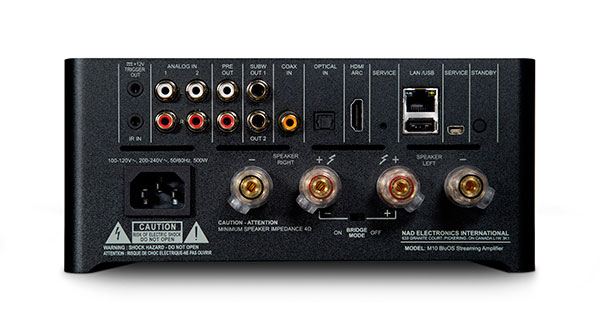
NAD Masters Series M10 performance
Connected to an LG 55B7 OLED via HDMI ARC, and running a pair of Spendor A1 standmount speakers underpinned by a BK Electronics P12-300SB subwoofer, the wisdom of NAD’s approach to the M10 makes itself felt pretty quickly.
Initially running with no Dirac and a crossover on the speakers, the performance is still impressive. The climactic fight around the tower in Bumblebee (Blu-ray) has plenty
of heft to it and the NAD’s handling of the Spendors delivers tonal accuracy and plenty of headroom in reserve.
If this was all the M10 was able to do, it would still be worthwhile, but making use of the additional bass management and EQ functions improves matters considerably. Setting a 70Hz crossover on the M10, and maxing the crossover on the BK Electronics, leads to a much happier relationship between speaker and subwoofer and removes some of the feeling of overlap that was present before. Running Dirac Live is slightly anticlimactic because, in my room at least, the subwoofer was exhibiting mostly benign characteristics. But even here it is able to correct a small peak in output around the 40Hz region.
With this done, my M10-driven system achieves something that every 2.1 set should: it doesn’t sound like a 2.1 system, just two effortlessly full-range speakers. The blend between speakers and sub is seamless and the result is a genuinely engrossing performance. Even though there's no surround processing at work at all, the scenes inside the tanker hulk in Blade Runner 2049 (Blu-ray) place me right within the vast space. There isn’t the slightest sense of any form of gap between the two Spendor speakers; instead you are treated to a beautifully judged soundstage.
My time with the M10 coincided with a strong urge for a Person of Interest marathon (Netflix) and it proved equally fine at handling the wide spread of sonic milieus that the series throws up. Crucially, it never fails to keep dialogue intelligible and blended within the L/R stage.
It should go without saying that when you want this brainiac amplifier to play some music, the performance is superb. And yet it still benefits from the bass management options. The enormously entertaining Resonant Body by Octo Octa (via Spotify) absolutely hammers along, with the NAD M10 integrating my BK Electronics subwoofer and keeping it under control. And it's worth stressing that even very large collections of music don’t phase the BluOS app, and this encourages you to delve through your library to check out things you haven’t listened to for years.
NAD Masters Series M10 verdict
What NAD has achieved with the Masters Series M10 amplifier should not be underestimated. Yes, this is
a stereo system, but one that regards AV as a critical
part of its capabilities. The result is something that's
a fantastic solution for spaces where a full multichannel setup isn’t practical.
Even better, there's no obvious compromise to any aspect of its two-channel music performance, and it comes wrapped in one of the best pieces of industrial design on the market. It's a truly outstanding product that should be on anyone’s shortlist at or anywhere near the price.
Verdict
NAD Masters Series M10
£2,200
nadelectronics.com
We say: NAD has built one of the most comprehensively specified devices going, and it does everything with staggering levels of competence.
Performance: 5/5
Design: 5/5
Features: 5/5
Overall: 5/5
Specification
Amplification (claimed): 2 x 100W HybridDigital (into 8 ohms, 20Hz-20kHz, two channels driven)
Integrated services: Tidal; Qobuz; Spotify; Deezer; Amazon Music HD; internet radio via vTuner
Connections: 1 x HDMI ARC; 1 x optical digital audio input; 1 coaxial digital audio input; 2 x analogue stereo phono inputs; 2 x subwoofer pre-outs; 1 x stereo phono pre-out; Ethernet; USB; 12V trigger; IR input
Dimensions: 100(h) x 215(w) x 260(d)mm
Weight: 5kg
Features: BluOS app (Android/iOS); Bluetooth aptX HD (send and receive); Wi-Fi built in; Apple AirPlay 2; UPnP server and renderer; MQA, FLAC, WAV and AIFF hi-res audio file support (up to 32-bit/192kHz); 1GHz processor; Dirac Live (upgradable to Dirac Live Full Frequency); colour front-panel display with touchscreen control; dual subwoofer crossover adjustment; tone control; Amazon Alexa voice interaction; multiroom support via BluOS
 |
Home Cinema Choice #351 is on sale now, featuring: Samsung S95D flagship OLED TV; Ascendo loudspeakers; Pioneer VSA-LX805 AV receiver; UST projector roundup; 2024’s summer movies; Conan 4K; and more
|




